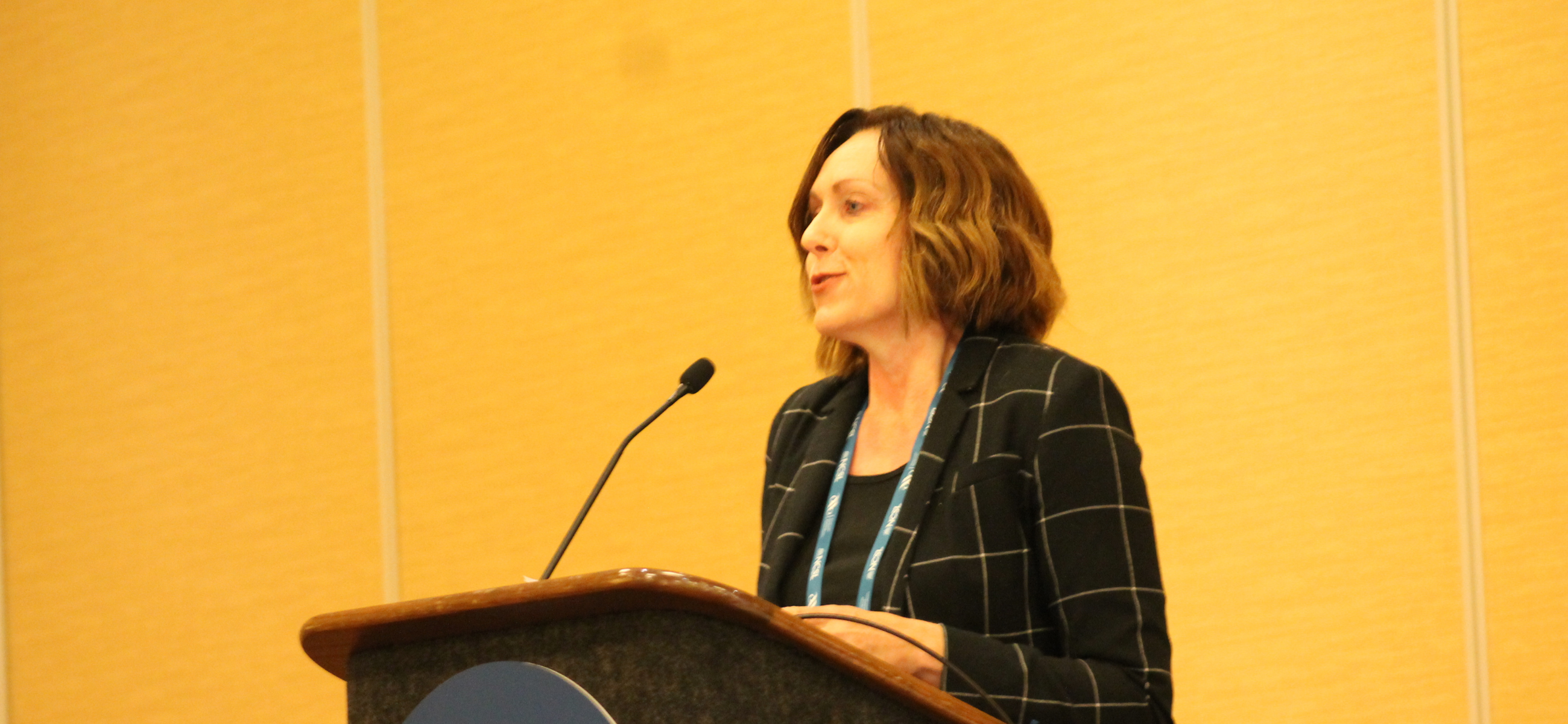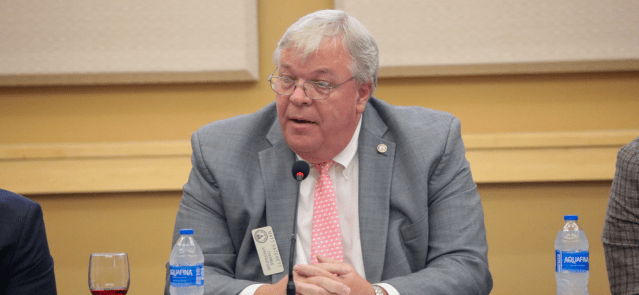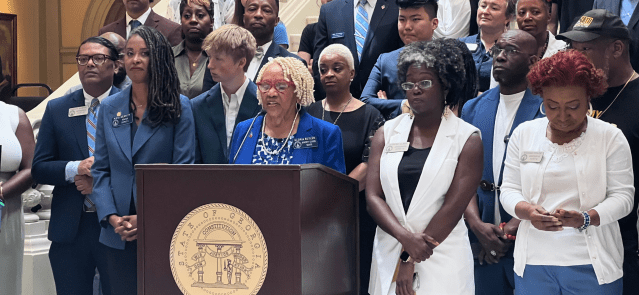Stay ahead of the curve as a political insider with deep policy analysis, daily briefings and policy-shaping tools.
Request a DemoStates tackle worker shortages despite low unemployment rates

Jennifer Sherer, director of the state worker power initiative at the Washington, D.C.-based Economic Policy Institute (EPI), speaks at the 2023 National Conference of State Legislatures. (credit: Jarred Meeks)
INDIANAPOLIS — The workforce development challenges facing U.S. states can be distilled to a single point for one panelist at the 2023 National Conference of State Legislatures: Not enough people are participating in the workforce. Another panelist alluded to a possible remedy — invest in workers.
As the country’s unemployment rate sits at 3.5%, the functional equivalent of what economists have long dubbed “full employment,” workforce development leaders have turned to other markers to explore ways to solve their state’s employment woes.
Doug Howard, vice president of government service company Maximus, said approximately 5.8 million people are unemployed while there are “about 9.8 million unfilled jobs.” The labor force participation rate was 62.6% for the fifth consecutive month in July, according to the U.S. Bureau of Labor Statistics. “The labor force participation rate has fallen from 66.8% to under 62% under a 20 year period,” Howard said. “That equals a math problem.”
Howard told a gathering of state legislators from across the country attending the annual conference that more workers are needed and that reskilling workers, attracting retirees and exploring immigration policies could potentially increase the nation’s number of employed workers.
The other speaker on the panel, Jennifer Sherer, director of the state worker power initiative at the Washington, D.C.-based Economic Policy Institute (EPI), listed what the institute believes are other contributing factors to the national workforce development challenges.
Sherer, citing EPI data, said there has been a decoupling of worker compensation from worker productivity dating back to 1979. Between 1948 and 1979, worker productivity increased at 118.4% while compensation increased by 107.5%. But between 1979 and 2021, productivity increased 64.9% while compensation only increased by 17.3%.
In other words, people are working harder for less pay.
According to Sherer, the recent 42-year trend of wage stagnation “really represents the growing income and wealth inequality that has plagued our economy for decades.” Though, EPI data also indicates low-wage workers experienced the strongest wage growth during the pandemic.
Nevertheless, the U.S. economy, particularly its labor market, is “remarkably strong,” by Sherer’s estimation. Since February 2020, the last pre-pandemic reference point, the economy has gained 4 million jobs, and the unemployment rate has been below 4% for more than a year. “In raw numbers, this is just a remarkable, quick two-year span of job growth — the highest in post-World War II history, in percentage terms,” Sherer said, noting the span represents the “strongest years of job growth since 1971.”
Additionally, the percentage of prime-age workers — ages 25-54 — is at its highest rate since 2001, and the percentage of prime-age female workers is at its highest level ever.
Yet the public sector has struggled to keep pace with the private sector. The U.S. Bureau of Labor Statistics finds that total private sector employment has risen by 3.2%, as of July, from February 2020 levels. In comparison, the public sector has seen a decrease of 1.2%.
“In the state sector, almost all of the gap can be accounted for by education,” Sherer said. “A significant number can be attributed to public education.”
EPI tracks how much teachers make in each state compared to their equivalently educated peers, finding educators are typically paid much less. To solve the issue, Sherer called for legislators to invest in public-sector education workforces and explore various apprenticeship programs.
The problem “predated the pandemic,” according to Sherer, who emphasized that roughly one-third of state and local government workers are paid less than $20 an hour — what she said was an “unlivable wage.”
“If we want to solve this shortfall, we have to listen to workers first,” Sherer said. “If we try to guess what the underlying issues are, we are likely to guess wrong. … It’s a chicken and egg problem spiraling at this point. As we allow those shortfalls to continue, it means those who are left behind in the workforce are being asked to do more with less.”
Jarred Meeks is a Statehouse reporter with State Affairs Pro Indiana. Contact Jarred on Twitter @jarredsmeeks or email him at [email protected].
Twitter @StateAffairsIN
Facebook @stateaffairsin
Instagram @stateaffairsin
LinkedIn @stateaffairspro
Header Image: Jennifer Sherer, director of the state worker power initiative at the Washington, D.C.-based Economic Policy Institute (EPI), speaks at the 2023 National Conference of State Legislatures. (credit: Jarred Meeks)
Read more on Georgia’s workforce:
Professionals still face licensing delays amid state’s transition to online system
The Gist Georgia’s professionals and business owners are still struggling to obtain professional licenses in a timely manner. As the Secretary of State’s Office rolls out its new Georgia Online Application Licensing System to expedite the process, the efficiency of this new process is being put to the test. What’s Happening Thursday morning at the …
Controversy over AP African American Studies class grows
Rashad Brown has been teaching Advanced Placement African American Studies at Atlanta’s Maynard Jackson High School for three years. He’ll continue to do so — even though the state’s top education official removed it from the list of state-funded course offerings for the upcoming school year. While Brown prepares to start teaching his class on …
Students, teachers, lawmakers blast decision to end AP African American history classes
ATLANTA — A coalition of lawmakers, civil rights leaders, clergy, educators and students Wednesday called on the state’s education czar to rescind his decision to drop an advanced placement African American studies class from the state’s curriculum for the upcoming school year. “This decision is the latest attack in a long-running GOP assault on Georgia’s …
Kamala Harris’ presidential bid reinvigorates Georgia Democrats
Georgia Democrats have gained new momentum heading into the November election, propelled by President Joe Biden’s decision to bow out of his reelection bid and hand the reins to Vice President Kamala Harris. The historic decision, announced Sunday, is expected to prove pivotal in the national and state political arenas and breathe new life and …




